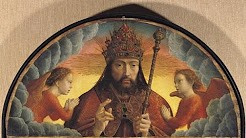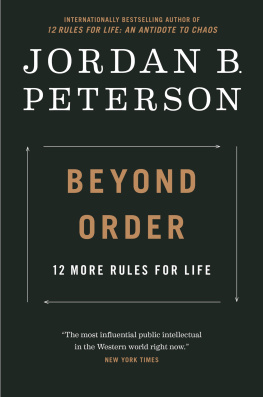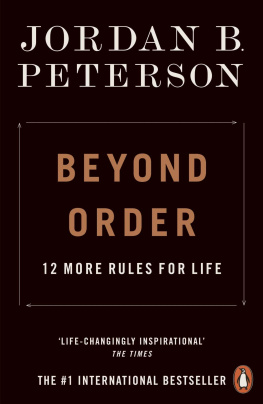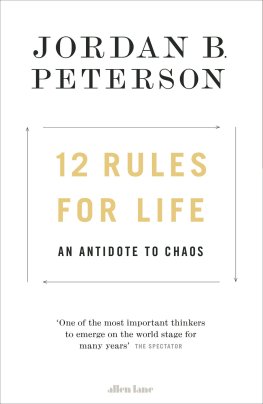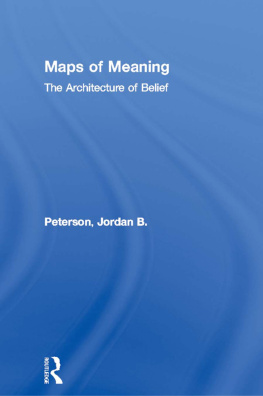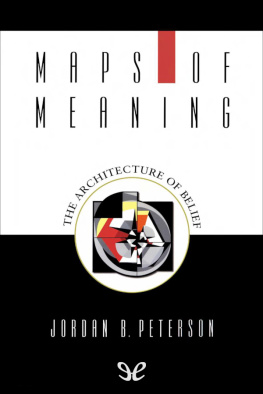MAPS OF MEANING
MAPS OF MEANING
The Architecture of Belief
JORDAN B. PETERSON
ROUTLEDGE
New York and London
Published in 1999 by
Routledge
29 West 35th St.
New York, NY 10001
This edition published in the Taylor & Francis e-Library, 2002.
Published in Great Britain by
Routledge
11 New Fetter Lane
London EC4P 4EE
Copyright 1999 by Routledge
All rights reserved. No part of this book may be reprinted or reproduced or utilized
in any form or
by any electronic, mechanical, or other means, now known or hereafter invented,
including photocopy
ing and recording or in any information storage or retrieval system, without
permission in writing from
the publishers.
Library of Congress Cataloging-in-Publication Data.
Peterson, Jordan B.
Maps of meaning: the architecture of belief/Jordan B.Peterson.
p. cm.
Includes bibliographical references and index.
ISBN 0-415-92221-6 (hardcover).ISBN 0-415-92222-4 (pbk.)
1. Archetype (Psychology) 2. Meaning (Psychology) I. Title.
BF175.5.A72P48 1999
150.1-dc21 98-37486
CIP
ISBN 0-203-90285-8 Master e-book ISBN
ISBN 0-203-90286-6 (OEB Format)
ISBN 0-415-92221-6 (Print Edition)
CONTENTS
FIGURES
The Domain and Constituent Elements of the Known
The Metamythological Cycle of the Way
Normal Life
Revolutionary Adaptation
The Ambivalent Nature of Novelty
Emergence of Normal Novelty in the Course of Goal-Directed Behavior
Emergence of Revolutionary Novelty in the Course of Goal-Directed Behavior
The Motor and Sensory Units of the Brain
The Regeneration of Stability from the Domain of Chaos
The Motor Homunculus
The Twin Cerebral Hemispheres and Their Functions
The Multiple Structure of Memory
Abstraction of Wisdom, and the Relationship of Such Abstraction to Memory
Conceptual Transformation of the Means/Ends Relationship from Static to Dynamic
Bounded Revolution
Nested Stories, Processes of Generation, and Multiple Memory Systems
The Constituent Elements of Experience
The Positive Constituent Elements of Experience, Personified
The Birth of the World of Gods
The Death of Apsu, and the (Re)Emergence of Tiamat as Threat
World of Gods: Hierarchical Organization
The Enuma elish in Schematic Representation
The Battle Between Osiris and Seth in the Domain of Order
The Involuntary Descent and Disintegration of Osiris
The Birth and Return of Horus, Divine Son of Order and Chaos
Voluntary Encounter with the Underworld
Ascent, and Reintegration of the Father
The Constituent Elements of Experience as Personality, Territory and Process
The UroborosPrecosmogonic Dragon of Chaos
The Birth of the World Parents
The Constituent Elements of the World, in Dynamic Relationship
Novelty, the Great Mother, as Daughter of the Uroboros
The Spontaneous Personification of Unexplored Territory
Unexplored Territory as Destructive Mother
Unexplored Territory as Creative Mother
The Heavenly Genealogy of the Destructive and Creative Mothers
The Exploratory Hero as Son of the Heavenly Mother
The Metamythology of the Way, Revisited
Castle, Hero, Serpent and Virgin: St. George and the Dragon
The Process of Exploration and Update, as the Meta-Goal of Existence
Order, the Great Father, as Son of the Uroboros
Explored Territory as Orderly, Protective Father
Explored Territory as Tyrannical Father
The Heavenly Genealogy of the Tyrannical and Protective Fathers
The Exploratory Hero as Son of the Great Father
The Death and Rebirth of the Adolescent Initiate
The Paradigmatic Structure of the Known
The Known: Nested Groups and Individuals
The Fragmentary Representation of Procedure and Custom in Image and Word
The Dual Death of the Revolutionary Hero
The Crucified Redeemer as Dragon of Chaos and Transformation
The Socially Destructive and Redemptive Journey of the Revolutionary Hero
The (Voluntary) Descent of the Buddha
The World-Tree as Bridge Between Heaven and Hell
The World-Tree and the Constituent Elements of Experience
Genesis and Descent
The Devil as Aerial Spirit and Ungodly Intellect
The Vicious Circle of the Adversary
The Constituent Elements of Existence, Reprise
The Emergence of Christ from Group Identity and Chaos
World-Tree of Death and Redemption
The Alchemical Opus as Normal Story
The Alchemical Opus as Revolutionary Story
The Wolf as Prima Materia, Devouring the Dead King
Dragon of Chaos as Birthplace of Christ and the Lapis
The Alchemical Opus as Myth of Redemption
The Restitution of [Christ] the Mystic Apple to the Tree of Knowledge
The Eternal Return of the Boddhisatva
I will utter things which have been kept secret from the foundation of the world.
(Matthew 13:35)
Preface
DESCENSUS AD INFEROS
Something we cannot see protects us from something we do not understand. The thing we cannot see is culture, in its intrapsychic or internal manifestation. The thing we do not understand is the chaos that gave rise to culture. If the structure of culture is disrupted, unwittingly, chaos returns. We will do anything-anything-to defend ourselves against that return.
The very fact that a general problem has gripped and assimilated the whole of a person is a guarantee that the speaker has really experienced it, and perhaps gained something from his sufferings. He will then reflect the problem for us in his personal life and thereby show us a truth.
I was raised under the protective auspices, so to speak, of the Christian church. This does not mean that my family was explicitly religious. I attended conservative Protestant services during childhood with my mother, but she was not a dogmatic or authoritarian believer, and we never discussed religious issues at home. My father appeared essentially agnostic, at least in the traditional sense. He refused to even set foot in a church, except during weddings and funerals. Nonetheless, the historical remnants of Christian morality permeated our household, conditioning our expectations and interpersonal responses, in the most intimate of manners. When I grew up, after all, most people still attended church; furthermore, all the rules and expectations that made up middle-class society were Judeo-Christian in nature. Even the increasing number of those who could not tolerate formal ritual and belief still implicitly acceptedstill acted outthe rules that made up the Christian game.
When I was twelve or so my mother enrolled me in confirmation classes, which served as introduction to adult membership in the church. I did not like attending. I did not like the attitude of my overtly religious classmates (who were few in number) and did not desire their lack of social standing. I did not like the school-like atmosphere of the confirmation classes. More importantly, however, I could not swallow what I was being taught. I asked the minister, at one point, how he reconciled the story of Genesis with the creation theories of modern science. He had not undertaken such a reconciliation; furthermore, he seemed more convinced, in his heart, of the evolutionary viewpoint. I was looking for an excuse to leave, anyway, and that was the last straw. Religion was for the ignorant, weak and superstitious. I stopped attending church and joined the modern world.
Although I had grown up in a Christian environmentand had a successful and happy childhood, in at least partial consequenceI was more than willing to throw aside the structure that had fostered me. No one really opposed my rebellious efforts, either, in church or at homein part because those who were deeply religious (or who might have wanted to be) had no intellectually acceptable counter-arguments at their disposal. After all, many of the basic tenets of Christian belief were incomprehensible, if not clearly absurd. The virgin birth was an impossibility; likewise, the notion that someone could rise from the dead.


